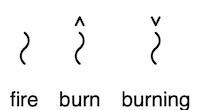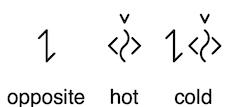Some new features have been added to the Baby Bliss Bot’s adaptive palette for composing symbols based on the Fundamental Rules of Blissymbolics. These are the ability for users to add or remove indicators and modifier symbols.
Indicators
Indicators are small Bliss-characters that are used as grammatical and semantic markers. They can be added or removed from a Bliss-word to change its meaning to a related one. For example, the plural indicator changes a word from its singular to its plural form. An example of composing the plural form is shown in Figure 1 where the Bliss-word representing the concept “I” becomes “We” by adding the plural indicator above the symbol for “person”. The plural indicator is the character that resembles a small “x”, meaning “multiple”.

Figure 2 shows how adding the verb indicator changes the word for “fire” into “burn”, or, alternatively, capturing the concept of “fire in action”. Then, substituting the descriptive indicator for the verb indicator changes the word to the adjective “burning”.

There are approximately 39 different indicator symbols that can used with Bliss-words to change their base meaning to represent other related concepts.
Modifiers
Modifier Bliss-characters are prefixes and suffixes that also change the meaning of the Bliss-words. Unlike indicators, however, modifiers are the same size as the Bliss-word they modify and are placed either before or after it. In addition, it is possible to add multiple modifiers to the same word.
An example is the “opposite” modifier character. It resembles a vertical line with pointers at the top and bottom. When combined with a Bliss-word, it creates the antonym of the original word. An example in English is the word “true” whose opposite is “false”. But, the same concept can be written using the phrase “opposite of true”.
Figure 3 shows using of the “opposite” modifier as a prefix to create a symbol that represents “cold” based on the one that represents “hot”.

There are 18 modifiers in the authorized vocabulary currently. Since modifiers can be applied in combination with each other, many new Bliss-words can be created by the resulting compositions. Along with indicators, Blissymbolics provides a constructive way of composing Bliss-words from existing ones and thereby representing many different concepts. The adaptive palette software encodes the rules for indicators and modifiers in order to allow users to compose sequences of Bliss symbols from a basic set of symbols. In fact, all of the examples here were created by using the palette and taking screen shots of the composed symbol. In this way the palette mirrors some of the compositional features of the Bliss language that allows users to combine existing symbols to “spell” other concepts, and thereby express themselves.